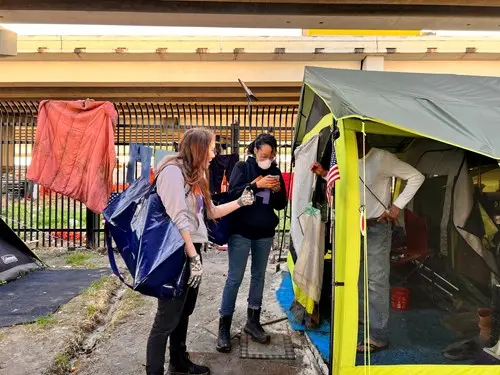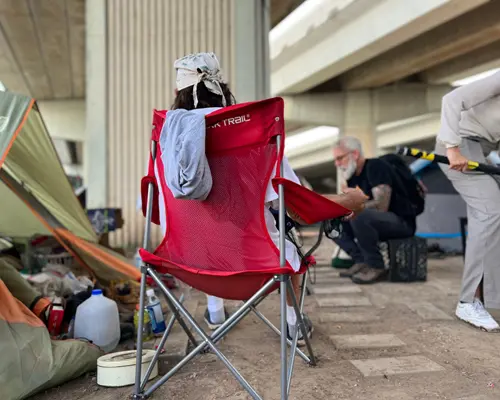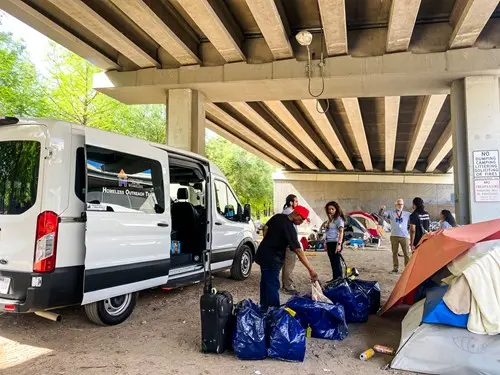What I wish Houstonians understood about homelessness
I first came on as interim president and CEO of the Coalition for the Homeless of Houston/Harris County in 2019. The CFTH is an independent nonprofit organization that was founded in 1982. We’re somewhat unique in that we do not provide direct services to people experiencing homelessness; we’re more like “air traffic control” for the homeless response system, which is called The Way Home. In short, we coordinate the collective impact.
When I started at CFTH, I didn’t know much about the issue of homelessness. Fortunately I had several subject matter experts close at hand on our executive team and at our partner organizations to teach me everything I needed to know.
What I did know was that my daughter was angry with me (and my entire generation) for allowing anyone to sleep on the streets.
In the years since, I have transitioned from “interim” to permanent CEO and learned a whole lot more about what causes homelessness and how we can solve it. Here’s what I wish my fellow Houstonians knew.
Homelessness is a housing problem.
Why do people fall into homelessness? Generally speaking, because they cannot find housing they can afford. This is true on a national level.[1] This may sound trite, but consider how many other explanations are often given for homelessness: drug abuse, mental illness, etc. Not to say that those issues don’t play a role in homelessness, but they are not the primary underlying problem.
I have heard it explained this way: imagine a game of musical chairs. You have ten players but only nine chairs. One of the players has a sprained ankle and is on crutches. When the music stops, who do you think is left without a chair? The player with the sprained ankle.
If I were to ask you why that player lost, you might say, “because she had a sprained ankle.” But that’s simply the precipitating event that led to her loss. The underlying cause was that there weren’t enough chairs for all of the players.
Similarly, it’s easy to look at issues like drug use or mental illness and say they’re causing homelessness. But consider this: we all have family and friends who have struggled with substance abuse and/or mental illness, but chances are, they didn’t end up homeless. The difference was they weren’t living in poverty and experiencing housing instability.
According to the National Low Income Housing Coalition, for the Houston-The Woodlands-Sugar Land metropolitan area, there are only 47 affordable and available homes for every 100 very low-income renter households (those making less than about $35,000) and only 19 per 100 renter households at or below extremely low income (those making less than about $21,300).[2] And the affordability gap is only growing.[3] That’s why we have homelessness.

It takes many partners working together to end homelessness.
Back in 2011, before we had a coordinated homeless response system, we had the sixth-largest homeless population in the country, almost 9,000 people. We were spending millions to address homelessness but making little progress. Homeless service providers were operating in silos, with no collaboration. Recidivism (repeated instances of homelessness) was high. The system was messy and confusing. No one knew where to go to get help, and there was no clearly defined goal for people experiencing homelessness.
In short, we were responding to homelessness rather than solving it/managing it rather than ending it.
We all agreed that we had to do a better job.
So partners and funders came together to identify a common goal for the homeless response system: housing. And we built the structure that we have today: an integrated network of providers coordinating to achieve maximum impact called The Way Home!
Today, the 100+ public and private partners of The Way Home work together to make homelessness rare, brief, and non-recurring in our region. With the CFTH as the lead agency, the basis of the success of The Way Home over the last decade has been strategic coordination between service providers and funders. We seek to make the highest and best use of available funding through a data-driven approach to serve the most vulnerable people first — with a focus on housing paired with supportive services.
Housing is the solution to homelessness.
It may sound obvious: give someone a home, and they’re no longer homeless. Our data show this surprisingly straightforward-sounding approach works. Approximately 90% of people housed through The Way Home don't return to homelessness within two years.
The approach we follow is called “housing first,” which means that there are no preconditions to getting housing. Housing first does not mean housing only. Our “clients” (as we call them) are placed in their own home (usually an apartment), with their name on the lease — and then, crucially, we offer voluntary supportive services to help them stay there.
Think about it this way: if someone went to the emergency room because they cut their hand … do you think they should be required to pass a kitchen safety course before they are stitched up? Imagine providing drug counseling to someone living in a tent under a bridge, versus to someone in an apartment. Which intervention do you think is more likely to “stick?”
Even if you don’t share our belief that housing is a human right and that no one should have to “prove” they’re ready for housing, you can’t argue with that fact that providing permanent housing with supportive services is, in fact, much less expensive to the taxpayer than allowing someone to remain homeless. According to national estimates, a single person experiencing chronic homelessness costs taxpayers $30,000 to $50,000/year. On the other hand, we estimate that it costs just $18,000/year to provide someone with housing and supportive services (offered by a professional case manager).

Most people experiencing homelessness don’t want to be.
There is a (sadly) common misconception that people live in tents and under freeways because they want to be there. That is not consistent with our observations. It’s true that some people who are experiencing homelessness choose to live unsheltered, in an encampment rather than stay in an emergency shelter. (This might be because the shelter can’t accommodate their pet, their boyfriend/girlfriend, or their work hours.) But most people living unsheltered will accept an offer of their own apartment.
From April 2021 to March 2022, we were able to use additional COVID relief funding to decommission 57 encampments at 28 sites across Houston. Of a total of 343 encampment residents engaged, 307 (89.5%) accepted our offer of housing or self-resolved! That’s a strong indicator that people do want to go into housing.
It's also worth mentioning just how important it is that our partners work together help vulnerable people navigate the complex housing process. Even if we had enough affordable and accessible apartment units to house every person experiencing homelessness, all the steps and paperwork involved could be a deterrent for a lot of folks, especially those trying to overcome the trauma of sleeping on the streets. That’s why the role of the housing navigator is so important.
The partners of The Way Home have housed more people than would fit in the Dynamo stadium.
We acknowledge that it can be hard to appreciate Houston’s progress on homelessness when you’re on certain blocks downtown and see people who appear to be experiencing homelessness — or see encampments in vacant lots or under freeways. And on the flip side the progress (the people who are no longer experiencing homelessness) is hard to see because they are now living in their own homes.
We know there is still a lot of work to be done. We would never claim to have solved homelessness. We cannot prevent people falling into homelessness until there is no more poverty and we have adequate housing stock that matches the profile of our citizens.
But, working together, over the past decade, the partners of The Way Home have housed more than 28,000 people. That’s greater than the capacity of the Dynamo stadium! And, as mentioned previously, most of them stay housed for at least two years.
That’s why Houston is a national model in ending homelessness.

People experiencing homelessness are people, and every person is different.
Perhaps most important, I want everyone to know that people who are experiencing homelessness are people.
Every individual or family that has experienced homelessness has their own — often very sad — story. Once they are housed, the way out of their trauma requires individual support. For some, psychiatric drugs are an answer. For others, the same drugs are kryptonite — the same with religion or other support.
However, nothing works until the person is safe from the harm and threats of living outside in fear. That’s why permanent housing with supportive services is the best solution.
I truly believe that. I have seen this approach transform people’s lives for the better. That’s why I have stayed on at the CFTH as long as I have — and hopefully I have made my daughter proud.
[1] https://homelessnesshousingproblem.com/
[2] https://nlihc.org/gap/state/tx
[3] https://kinder.rice.edu/research/2022-state-housing-harris-county-and-houston